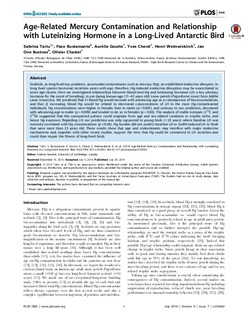| dc.contributor.author | Tartu, Sabrina | |
| dc.contributor.author | Bustamante, Paco | |
| dc.contributor.author | Goutte, Aurélie | |
| dc.contributor.author | Weimerskirch, Henri | |
| dc.contributor.author | Bustnes, Jan Ove | |
| dc.contributor.author | Chastel, Olivier | |
| dc.date.accessioned | 2014-08-07T12:44:57Z | |
| dc.date.accessioned | 2018-01-23T18:25:17Z | |
| dc.date.available | 2014-08-07T12:44:57Z | |
| dc.date.available | 2018-01-23T18:25:17Z | |
| dc.date.issued | 2014 | |
| dc.identifier.citation | PLoS ONE 2014, 9(7) | nb_NO |
| dc.identifier.issn | 1932-6203 | |
| dc.identifier.uri | http://hdl.handle.net/11250/2479211 | |
| dc.description.abstract | Seabirds, as long-lived top predators, accumulate contaminants such as mercury (Hg), an established endocrine disruptor. In
long lived species hormonal secretion varies with age; therefore, Hg-induced endocrine disruption may be exacerbated in
some age classes. Here we investigated relationships between blood total Hg and luteinizing hormone (LH, a key pituitary
hormone for the onset of breeding), in pre-laying known-age (11–45 years old) snow petrels (Pagodroma nivea) from Ade´ lie
Land, Antarctica. We predicted that 1) blood Hg would increase with advancing age as a consequence of bio-accumulation;
and that 2) increasing blood Hg would be related to decreased concentrations of LH in the most Hg-contaminated
individuals. Hg concentrations were higher in females than in males (p,0.001), and contrary to our prediction, decreased
with advancing age in males (p = 0.009) and tended to do so in females (p = 0.06). The analysis of stable isotopes (d13C and
d15N) suggested that this unexpected pattern could originate from age and sex-related variations in trophic niche, and
hence Hg exposure. Regarding LH, our prediction was only supported in young birds (#23 years) where baseline LH was
inversely correlated with Hg concentrations (p = 0.04). Hg burden did not predict baseline LH or GnRH-induced LH in birds
that were more than 23 years old. These results show that age and contaminants may interfere with major endocrine
mechanisms and, together with other recent studies, support the view that Hg could be connected to LH secretion and
could then impair the fitness of long-lived birds. | nb_NO |
| dc.language.iso | eng | nb_NO |
| dc.rights | Navngivelse 4.0 Internasjonal | * |
| dc.rights.uri | http://creativecommons.org/licenses/by/4.0/deed.no | * |
| dc.title | Age-Related Mercury Contamination and Relationshipwith Luteinizing Hormone in a Long-Lived Antarctic Bird | nb_NO |
| dc.type | Journal article | nb_NO |
| dc.type | Peer reviewed | nb_NO |
| dc.date.updated | 2014-08-07T12:44:57Z | |
| dc.description.version | publishedVersion | nb_NO |
| dc.identifier.doi | 10.1371/journal.pone.0103642 | |
| dc.identifier.cristin | 1145762 | |
| dc.relation.project | Andre: The Agence Nationale de la Recherche, France | nb_NO |
| dc.relation.project | Andre: The Institut Polaire Franc¸ais Paul Emile Victor (IPEV no 10 | nb_NO |
| dc.relation.project | Andre: The Terres Australes et Antarctiques Franc¸aises (TAAF). | nb_NO |

